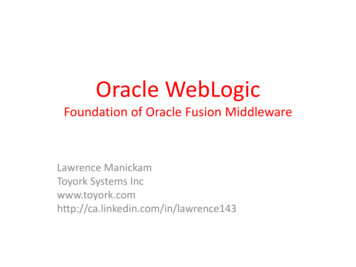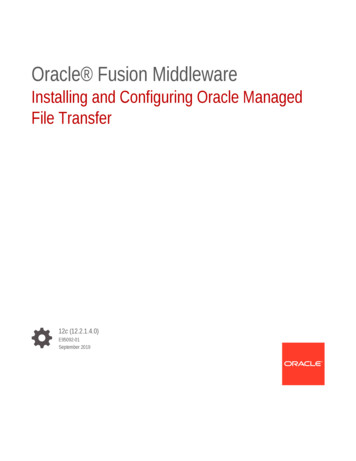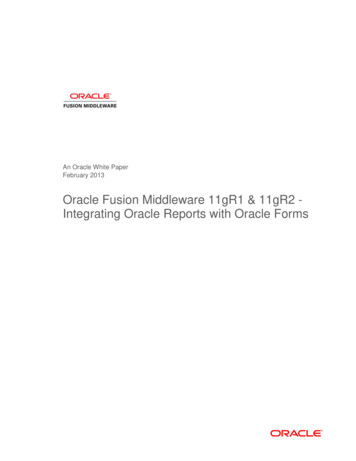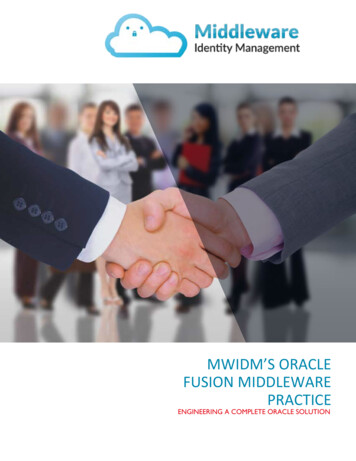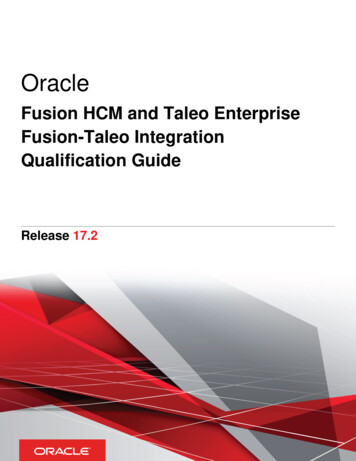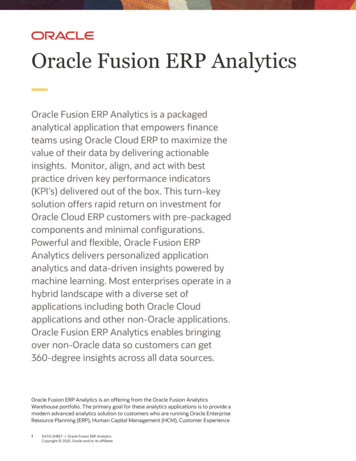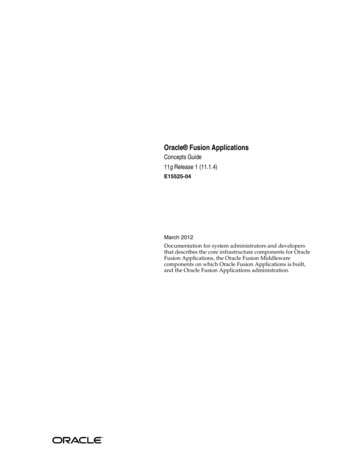
Transcription
Oracle Fusion ApplicationsConcepts Guide11g Release 1 (11.1.4)E15525-04March 2012Documentation for system administrators and developersthat describes the core infrastructure components for OracleFusion Applications, the Oracle Fusion Middlewarecomponents on which Oracle Fusion Applications is built,and the Oracle Fusion Applications administration.
Oracle Fusion Applications Concepts Guide, 11g Release 1 (11.1.4)E15525-04Copyright 2012, Oracle and/or its affiliates. All rights reserved.Primary Author: Vickie Laughlin (lead), John WilliamsThis software and related documentation are provided under a license agreement containing restrictions onuse and disclosure and are protected by intellectual property laws. Except as expressly permitted in yourlicense agreement or allowed by law, you may not use, copy, reproduce, translate, broadcast, modify, license,transmit, distribute, exhibit, perform, publish, or display any part, in any form, or by any means. Reverseengineering, disassembly, or decompilation of this software, unless required by law for interoperability, isprohibited.The information contained herein is subject to change without notice and is not warranted to be error-free. Ifyou find any errors, please report them to us in writing.If this is software or related documentation that is delivered to the U.S. Government or anyone licensing iton behalf of the U.S. Government, the following notice is applicable:U.S. GOVERNMENT RIGHTS Programs, software, databases, and related documentation and technical datadelivered to U.S. Government customers are "commercial computer software" or "commercial technical data"pursuant to the applicable Federal Acquisition Regulation and agency-specific supplemental regulations. Assuch, the use, duplication, disclosure, modification, and adaptation shall be subject to the restrictions andlicense terms set forth in the applicable Government contract, and, to the extent applicable by the terms ofthe Government contract, the additional rights set forth in FAR 52.227-19, Commercial Computer SoftwareLicense (December 2007). Oracle America, Inc., 500 Oracle Parkway, Redwood City, CA 94065.This software or hardware is developed for general use in a variety of information managementapplications. It is not developed or intended for use in any inherently dangerous applications, includingapplications that may create a risk of personal injury. If you use this software or hardware in dangerousapplications, then you shall be responsible to take all appropriate fail-safe, backup, redundancy, and othermeasures to ensure its safe use. Oracle Corporation and its affiliates disclaim any liability for any damagescaused by use of this software or hardware in dangerous applications.Oracle and Java are registered trademarks of Oracle and/or its affiliates. Other names may be trademarks oftheir respective owners.Intel and Intel Xeon are trademarks or registered trademarks of Intel Corporation. All SPARC trademarksare used under license and are trademarks or registered trademarks of SPARC International, Inc. AMD,Opteron, the AMD logo, and the AMD Opteron logo are trademarks or registered trademarks of AdvancedMicro Devices. UNIX is a registered trademark of The Open Group.This software or hardware and documentation may provide access to or information on content, products,and services from third parties. Oracle Corporation and its affiliates are not responsible for and expresslydisclaim all warranties of any kind with respect to third-party content, products, and services. OracleCorporation and its affiliates will not be responsible for any loss, costs, or damages incurred due to youraccess to or use of third-party content, products, or services.
ContentsPreface . vAudience.Documentation Accessibility .Related Documents .Conventions .vvvvWhat's New in This Guide for Release 11.1.4 . vii1 Introduction to Oracle Fusion 2.31.2.41.3What Is Oracle Fusion Applications?.Standards-Based Architecture .Best Practices Business Processes .Choice of Deployment Options .Security.Oracle Fusion Applications Architecture Design.Data Model and Business Logic Design .Business Process Design .Business Intelligence .Operational Management Design .Service-Oriented Architecture (SOA) .1-11-21-21-31-31-41-51-61-61-71-72 Key Concepts2.12.22.3Key Oracle Fusion Middleware Concepts for Oracle Fusion Applications . 2-1Oracle Fusion Applications Runtime Environment . 2-1Oracle Database. 2-23 Oracle Fusion Middleware Components for Oracle Fusion Applications3.13.23.3Oracle Fusion Middleware Extensions for Applications . 3-1Oracle Enterprise Scheduler . 3-2Oracle Enterprise Crawl and Search Framework (ECSF) . 3-34 Oracle Fusion Middleware Components4.14.2Oracle WebLogic Server. 4-1Oracle WebLogic Communication Services. 4-1iii
4.34.44.54.64.74.84.94.104.114.124.134.14Oracle Identity Management. 4-2Oracle WebCenter Portal . 4-3Oracle Business Intelligence . 4-3Oracle SOA Suite. 4-5Oracle Application Development Framework . 4-7Oracle JDeveloper . 4-9Oracle HTTP Server. 4-9Oracle HTTP Server WebGate . 4-9Oracle Web Services Manager Policy Manager. 4-10Oracle WebCenter Content. 4-10Oracle Data Integrator. 4-11Oracle Secure Enterprise Search . 4-115 Oracle Fusion Applications Administration and 75.85.95.105.11ivEnterprise Deployment .Management .Oracle Enterprise Manager Fusion Applications Control .Oracle WebLogic Server Administration Console.Oracle WebLogic Scripting Tool.Oracle Process Manager and Notification Server .Scalability .High Availability .Load Balancing .Logging and Diagnostic Testing Frameworks.Cloning .Backup and Recovery .Moving Oracle Fusion Applications .Patching .Oracle Fusion Functional Setup Manager .5-15-15-35-35-45-45-55-55-55-65-75-75-85-85-9
PrefaceThis guide provides an overview of the Oracle Fusion Applications architecture anddescribes the core infrastructure components of Oracle Fusion Applications, the OracleFusion Middleware components on which Oracle Fusion Applications is built, andOracle Fusion Applications Administration.AudienceThis document is intended for anyone who is interested in an overview of thecomponents and features that comprise Oracle Fusion Applications.Documentation AccessibilityFor information about Oracle's commitment to accessibility, visit the OracleAccessibility Program website athttp://www.oracle.com/pls/topic/lookup?ctx acc&id docacc.Access to Oracle SupportOracle customers have access to electronic support through My Oracle Support. Forinformation, visithttp://www.oracle.com/pls/topic/lookup?ctx acc&id info or visithttp://www.oracle.com/pls/topic/lookup?ctx acc&id trs if you arehearing impaired.Related DocumentsFor more information, see the following documents: Oracle Fusion Applications Administrator and Implementor Roadmap Oracle Fusion Applications Administrator's Guide Oracle Fusion Applications Installation Guide Oracle Fusion Applications Enterprise Deployment Guide Oracle Fusion Middleware Concepts Guide Oracle Fusion Middleware Administrator's GuideConventionsThe following text conventions are used in this guide:v
viConventionMeaningboldfaceBoldface type indicates graphical user interface elements associatedwith an action, or terms defined in text or the glossary.italicItalic type indicates book titles, emphasis, or placeholder variables forwhich you supply particular values.monospaceMonospace type indicates commands within a paragraph, URLs, codein examples, text that appears on the screen, or text that you enter.
What's New in This Guide for Release 11.1.4For Release 11.1.4, nothing in this guide has changed from the previous release.vii
viii
1Introduction to Oracle Fusion Applications1The Oracle Fusion service-oriented platform and applications suite joinsnext-generation enterprise technologies, applications, and services, including OracleFusion Applications and Oracle Fusion Middleware, to change the dynamics in theapplications marketplace and revolutionize business. This chapter provides anintroduction to the architecture and components of Oracle Fusion Applications.This chapter contains the following topics: What Is Oracle Fusion Applications? Oracle Fusion Applications Architecture Design Service-Oriented Architecture (SOA)For more information about Oracle Fusion Applications development andadministrative tasks, see the following: Oracle Fusion Applications Developer's Guide Oracle Fusion Applications Administrator's GuideFor more information about Oracle Fusion Middleware concepts, see the following: Oracle Fusion Middleware Concepts Oracle Fusion Middleware Administrator's GuideFor more information about Oracle Database, see Oracle Database 2 Day DBA.1.1 What Is Oracle Fusion Applications?Using the latest technology and incorporating the best practices gathered from Oracle'scustomers, Oracle Fusion Applications is a suite of 100% open standards-basedbusiness applications that provide a new standard for the way businesses innovate,work and adopt technology. Delivered as a complete suite of modular, service-enabledenterprise applications, Oracle Fusion Applications works with Oracle's ApplicationsUnlimited portfolio to evolve business to a new level of performance. Whether it is onemodule, a product family, or the entire suite, Oracle provides businesses with theirchoice of all advancements pioneered by Oracle Fusion Applications, at a pace thatmatches individual business demands.Oracle Fusion Applications can best be described as: Built on an open standards-based platform Based on best practices business processes Deployed through a selection of optionsIntroduction to Oracle Fusion Applications1-1
What Is Oracle Fusion Applications? Built with security as a priority1.1.1 Standards-Based ArchitectureOracle Fusion Applications is standards-based, making it highly adaptable. Thisstandards-based technology enables you to respond effectively to change with flexible,modular, user-driven business software that is powered by best-in-class businesscapabilities built on open standards. Its technology framework includes the followingproducts: Oracle WebCenter Portal provides design-time and runtime tools for buildingenterprise portals, transactional websites, and social networking sites.Oracle Business Intelligence 11g provides a full range of business intelligencecapabilities that enable you to analyze, present, report, and deliver organizationaldata.Oracle WebCenter Content enables you to leverage document management, Webcontent management, digital asset management; and records retentionfunctionality to build and complement your business applications.Oracle SOA Suite provides a complete set of service infrastructure components fordesigning, deploying, and managing SOA composite applications. Oracle SOASuite enables services to be created, managed, and orchestrated into SOAcomposite applications.Oracle WebLogic Server is a scalable, enterprise-ready application server based onJava Enterprise Edition (Java EE).Oracle JDeveloper is an integrated development environment with end-to-endsupport for modeling, developing, debugging, optimizing, and deploying Javaapplications and web services.Oracle Enterprise Manager offers business-driven applications management,integrated application to disk management, integrated systems management, andsupport experience.Oracle Identity Management enables organizations to manage the end-to-endlifecycle of user identities and to secure access to enterprise resources and assets.Using a standards-based architecture reduces the cost for integration and enables youto reuse systems and technologies. Standards-based architecture also increases theflexibility of the applications. You can fit the applications to your business byconfiguring not only the user interface, but also the business objects, the businessprocesses, the business logic, and business intelligence.The ease of managing Oracle Fusion Applications offers a low total cost of ownershipthat results in a faster return on investment by using tools for rapid setup and flexibledeployment models, as well as providing protection for upgrades.1.1.2 Best Practices Business ProcessesOracle Fusion Applications incorporates best practices business processes, includingthose from Oracle product lines, such as Oracle E-Business Suite, PeopleSoft, OracleOn Demand, JD Edwards, and Siebel to optimize the user experience and productivity.The Oracle Fusion Applications user interface facilitates the customer-driven, intuitivedesign of the applications that result in large productivity gains. The user interfacedesign of Oracle Fusion Applications is:1-2 Oracle Fusion Applications Concepts Guide
What Is Oracle Fusion Applications? Role-based, which enables pervasive delivery in multiple modes, devices, andchannelsConfigurable and extensible, through JDeveloper during design time or thecomposer during runtime, which enhances productivity for individual users andgroups of usersComposite and contextual, providing integrated information in the context ofprocessSocial and collaborative, offering built-in user communities and workspace, Web2.0 information distribution, and embedded social computing to improvecollaborative workSpecific features of the user interface include: Role-based dashboards that you can configure to your business needs Unified worklists that provide lists of tasks from across the applications Guided Business Processes, which are organized sets of tasks that help you getyour work done more efficientlyEmbedded analysis methods that provides the necessary information forcompleting a taskContextual help that provides conceptual and procedural reference informationOracle Fusion Applications Search, which provides a seamless search experiencefor easily locating and taking action on relevant dataTagging, which enables you to associate keywords with objects so they can beeasily locatedInstant collaboration that provides the contact information for persons related toyour tasks1.1.3 Choice of Deployment OptionsOracle Fusion Applications is delivered as a suite, but can be adopted modularly. Itcan be adopted as a single suite, as product offerings (the highest level collection offunctionality that you can license and implement), or as solutions sets that work withother Oracle Applications Unlimited product lines.Oracle Fusion Applications is offered with the following deployment options: On premise, hosted by the enterprisePublic cloud (available to the general public), hosted over the Internet by Oracle,software as a service (SaaS), or Oracle business partners offering business processoutsourcing (BPO) solutionsPrivate cloud (available internally behind a firewall), hosted as a SaaS or BPOofferingHybrid, an implementation of both on premise and cloud1.1.4 SecurityOracle Fusion Applications security offers: Role-based access Segregation of dutiesIntroduction to Oracle Fusion Applications1-3
Oracle Fusion Applications Architecture Design Consistent and transparent function and data security Robust privacy protections Native identity management and access provisioning Enforcement across tools (all the tools use the same policies) and across theinformation lifecycle Integration with Oracle Fusion Governance, Risk, and Compliance An extensive reference implementation Standard tools to extend the footprintFor more information about security for Oracle Fusion Applications, see the OracleFusion Applications Security Guide.1.2 Oracle Fusion Applications Architecture DesignOracle Fusion Applications follows a modular, standards-based architecture. It isnatively built on Oracle Fusion Middleware 11g components and uses OracleDatabase. Figure 1–1 illustrates the architecture of Oracle Fusion Applications.Figure 1–1 Oracle Fusion Applications Architecture1-4 Oracle Fusion Applications Concepts Guide
Oracle Fusion Applications Architecture DesignOracle Fusion Applications includes the following product families, or collections ofproducts that are associated with a functional area: Oracle Fusion Customer Relationship Management manages customers, contacts,and resources, including data quality configuration.Oracle Fusion Financials manages financial flows, including assets, ledgers, cashcycle, invoices and payments, accounts receivable, collections, and setup ofsubledger accounting and tax configuration.Oracle Fusion Governance, Risk, and Compliance integrates business intelligence,process management, and automated controls enforcement to enable sustainablerisk and compliance management.Oracle Fusion Human Capital Management provides employee management foran organization.Oracle Fusion Procurement manages the procurement process includingrequisitions, purchase orders, and supplier negotiations.Oracle Fusion Project manages projects, including how to plan, budget, forecast,collect costs, bill customers, and report performance.Oracle Fusion Supply Chain Management integrates and automates all key supplychain processes, from design, planning, and procurement to manufacturing andorder fulfillment.Oracle Fusion Setup is a special product family for supporting the other productfamilies.In addition to Oracle Fusion Functional Setup Manager for setting up functionaldata, this product family includes applications to assist application users:–The Oracle Fusion Home page provides a Welcome dashboard with acollection of portlets and task flows for answering common questions.–Oracle Fusion Applications Help delivers the content that users require inorder to complete their tasks. You can optionally install a local version ofOracle Fusion Applications Help, enabling you to extend and customize thehelp.Each product family is based on a common Oracle Fusion Applications data model andservices. Product families contain one or more Java EE applications that are specific toOracle Fusion Applications and deployed to Oracle WebLogic Server. An applicationcan contain multiple products, and a product can also span multiple applications. Aproduct typically has a one-to-one correspondence with an Enterprise Archive (EAR)file. For example, EarSales.ear is an application and Sales is a product.1.2.1 Data Model and Business Logic DesignOracle Fusion Applications uses a unified data model, which is a superset ofE-Business Suite, PeopleSoft, JD Edwards, and Siebel entities and attributes. You canextend this data model while maintaining consistent semantics.Logical data striping offers flexible enterprise structures for global organizations.Reference data sets enable business units to share reference data. Reference data ismanaged by sets. Transactional data is managed or striped by business units. You canassign sets of codes to each business unit. There is no need to duplicate reference datafor each business unit.Oracle Fusion Applications uses trees, a hierarchy model that offers flexible hierarchiesfor crossing line of business processes. It also defines line of business processes moreIntroduction to Oracle Fusion Applications1-5
Oracle Fusion Applications Architecture Designefficiently. The tree structure is in the data model and is used directly in the Javabusiness logic and exposed through Oracle Business Intelligence.Flexfields enable you to add custom attributes and define custom key structures inOracle Fusion Applications.A unified metadata dictionary, and a metadata store, accessible to all the tools, provideconsistency for all the components in the technology stack and enable you to preservechanges across upgrades.Unified concepts from existing and new applications support upgrades from otherApplications Unlimited product lines to Oracle Fusion Applications.1.2.2 Business Process DesignOracle Fusion Applications uses a declarative business process design that leveragesOracle SOA Suite. The SOA features used include approval management flows,human workflows, Oracle Business Process Management Worklist (Oracle BPMWorklist), business rules, activity guides, and process configuration customizationtools (Oracle SOA Composer). Integration, creating business processes, and humanworkflow is the same as it is done in SOA.The business process design of Oracle Fusion Applications features: Declarative business process definition, which enables processes to be definedcollaboratively between businesses and ITUnified business process execution through system, human, and documentworkflow in a single business process management foundation to optimizeprocesses while ensuring upgradeabilityUnified process visibility and analytics with cross-organization monitoring,tracing, and variance analysisFlexible business process customization, which enables you to make in-flightchanges to data models, rules, events, and processesShared business metadata dictionary, which contains all the BPEL rules andprocesses,During design time, two languages are used: Business Process Execution Language(BPEL) and Business Process Modelling Notation (BPMN), which share the sameengine and metadata dictionary.One SOA infrastructure is used per product family, but all worklists are available inone single location. For example, a worklist can include content from Oracle FusionCustomer Relationship Management and Oracle Fusion Financials.All business processes are configurable using a rich set of tools (BPM Composer, RulesEditor, Routing Editor, and Profile Editor) that enable you to optimize the processes asyou are using them.1.2.3 Business IntelligenceOracle Fusion Applications offers the following Oracle Business Intelligencecapabilities: Operational analysis, what-if analysis, analytic dashboards that enable you toadapt analytics to changes in transactional and process systems Unified analytic definitions and calculations Role-based dashboards with consistent security and navigation1-6 Oracle Fusion Applications Concepts Guide
Service-Oriented Architecture (SOA) Data mining-driven sales prediction, trending, and forecasting Reporting (pixel perfect reports designed for printing)A common repository product design is used across all Oracle Business Intelligenceproducts.For more information, see Chapter 4, "Oracle Fusion Middleware Components".1.2.4 Operational Management DesignThe operational management design for Oracle Fusion Applications offers: Unified business services level management to achieve a comprehensive lifecyclemanagementSingle point of administration for applications and technology to achievecomprehensive lifecycle managementCentralized management of users, privileges, and controls to simplify identitymanagement and controls enforcementFlexible deployment optionsOracle Enterprise Manager manages the middleware and the database. It provides anapplication-centric view, which shows information according to the product you havedeployed. It also enables you to drill down from the business process to thetechnology stack through a single dashboard.Rather than managing users and roles in themselves, Oracle Fusion Applicationsexternalizes both the users and the roles to reside in a Lightweight Directory AccessProtocol (LDAP) system. This identity management model centralizes access andentitlements, and is embedded in Oracle Fusion Applications.Oracle Fusion Governance, Risk, and Compliance manages separation of duty toensure that the roles do not overlap.1.3 Service-Oriented Architecture (SOA)Service-oriented architecture (SOA) provides an enterprise architecture that supportsbuilding connected enterprise applications to provide solutions to business problems.SOA facilitates the development of enterprise applications as modular business webservices that can be easily integrated and reused, creating a truly flexible, adaptable ITinfrastructure.SOA uses orchestration technology to assemble various services to providecomprehensive functionality. In Oracle Fusion Applications, many productapplications provide their functionality in the form of web services. Oracle BusinessProcess Management is used to assemble these web services to provide end-to-endfunctionality.Oracle SOA Suite, a middleware component of Oracle Fusion Middleware, provides acomplete set of service infrastructure components for designing, deploying, andmanaging SOA composite applications. It enables services to be created, managed, andorchestrated into SOA composite applications. Composites enable you to easilyassemble multiple technology components into one SOA composite application.For more information, see Section 4.6, "Oracle SOA Suite".Introduction to Oracle Fusion Applications1-7
Service-Oriented Architecture (SOA)1-8 Oracle Fusion Applications Concepts Guide
2Key Concepts2This chapter contains the following topics: Key Oracle Fusion Middleware Concepts for Oracle Fusion Applications Oracle Fusion Applications Runtime Environment Oracle Database2.1 Key Oracle Fusion Middlewar
The Oracle Fusion service-oriented platform and applications suite joins next-generation enterprise technologies, applications, and services, including Oracle Fusion Applications and Oracle Fusion Middleware, to change the dynamics in the applications marketplace and revolutionize business. This chapter provides an


